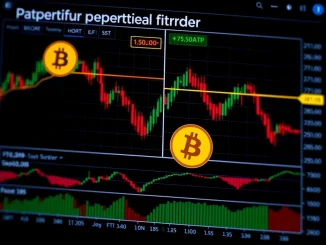
Hey crypto enthusiasts! Have you been feeling a shift in the air regarding the market lately? You’re not alone. A key indicator, the Crypto Fear and Greed Index, has just made a significant move, signaling a change in crypto market sentiment. Let’s dive into what this means.
What Does the Crypto Fear and Greed Index Tell Us?
The Crypto Fear & Greed Index, developed by Alternative, is a popular tool used by traders and investors to gauge the prevailing emotional state of the cryptocurrency market. Think of it as a thermometer for market mood. It ranges from 0 to 100:
- 0: Extreme Fear – This typically suggests investors are overly worried, which could be a potential buying opportunity for those who believe the market is oversold.
- 100: Extreme Greed – This indicates investors are getting too excited, which might mean the market is due for a correction.
Understanding this spectrum is crucial for interpreting the index’s movements.
Crypto Fear and Greed Index Reaches 67: Entering the Greed Zone
As of May 2, the index registered a value of 67. This is a notable jump of 14 points from the previous day’s reading. This surge pushed the index out of the ‘Neutral’ zone and firmly into the ‘Greed’ zone. While 67 isn’t near the extreme end of greed, it certainly reflects improved sentiment compared to recent times.
Why is this shift important? A move into the crypto greed zone often suggests increasing confidence among market participants. People are potentially more willing to buy, perhaps fearing missing out on potential gains (FOMO). However, seasoned traders also see high ‘Greed’ levels as a potential warning sign that the market might be getting overheated.
Factors Driving the Change in Crypto Market Sentiment
The Crypto Fear & Greed Index isn’t based on a single metric. It’s a composite index that takes into account six different factors, each weighted differently to provide a holistic view:
- Volatility (25%): How much the market is fluctuating. High volatility can signal fear or uncertainty.
- Market Momentum/Volume (25%): Analyzing current volume and momentum compared to recent averages. Strong buying volume typically indicates greed.
- Social Media (15%): Sentiment analysis of social media posts related to cryptocurrencies. High levels of positive or excited posts can indicate greed.
- Surveys (15%): While currently paused, this factor involves polling investors on their market outlook.
- Bitcoin Dominance (10%): The percentage of the total crypto market capitalization that belongs to Bitcoin. Increasing Bitcoin dominance can sometimes indicate a shift away from altcoins towards the perceived safety of Bitcoin, potentially signaling fear or caution in the broader market, though its interpretation can vary.
- Google Trends (10%): Analyzing search queries related to cryptocurrencies. Rising search interest for terms like ‘Bitcoin price manipulation’ might indicate fear, while searches for ‘buy crypto’ could indicate greed.
The combined movement across these factors contributed to the index’s recent rise and the shift towards ‘Greed’. The change suggests increased positive momentum, potentially lower perceived crypto volatility, and more positive social sentiment have played significant roles.
What Does Increased Greed Mean for You?
Seeing the index in the ‘Greed’ zone shouldn’t be the *only* factor in your investment decisions, but it’s a valuable piece of the puzzle. Here are some actionable insights:
- Stay Cautious: While positive sentiment is good, high greed levels historically precede market pullbacks. Don’t let FOMO dictate your strategy.
- Review Your Portfolio: Is it a good time to take some profits? Or perhaps rebalance your holdings?
- Do Your Own Research: The index is a sentiment tool, not a crystal ball. Always look at market fundamentals, technical analysis, and your own risk tolerance.
The index provides a snapshot of the market’s emotional state, which can be irrational. Understanding this sentiment, alongside other analysis methods, can help you navigate the market more effectively.
The Role of Bitcoin Dominance in the Index
It’s worth noting the inclusion of Bitcoin dominance as a factor. While it only accounts for 10%, shifts in Bitcoin’s market share can sometimes reflect broader market dynamics. For example, if Bitcoin dominance is rising alongside overall greed, it might suggest confidence is flowing disproportionately into the largest crypto asset. Conversely, falling dominance during a greedy phase could indicate speculative interest spreading across altcoins.
Conclusion: Navigating the Crypto Greed Zone
The jump in the Crypto Fear and Greed Index to 67 and its entry into the ‘Greed’ zone reflects a tangible improvement in crypto market sentiment. This shift, driven by factors like reduced crypto volatility and increased momentum, signals greater confidence among investors. However, as the saying goes, ‘Be fearful when others are greedy, and greedy when others are fearful.’ Use this information as a valuable indicator, but always combine it with thorough research and a disciplined approach to your crypto investments. The market’s emotional state can change quickly, so staying informed is key.



